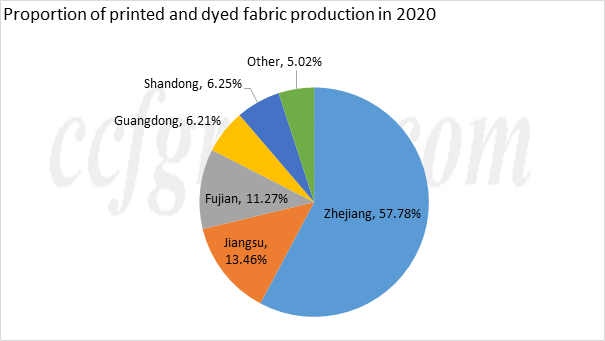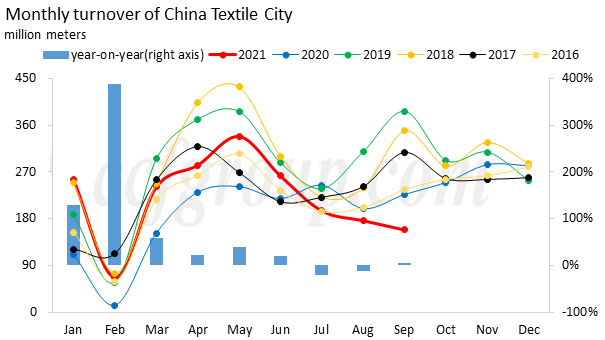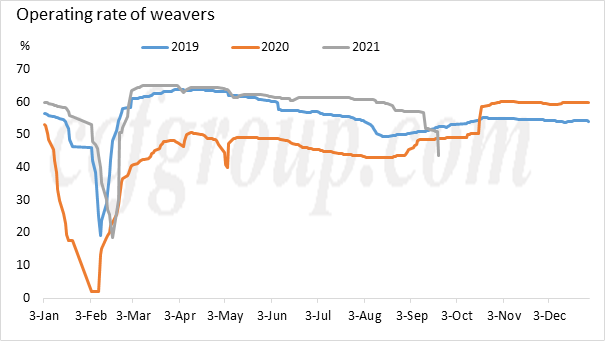How badly will weavers suffer in the electricity rationing of printing and dyeing mills?
It has only been 10 days since the electricity rationing and shutdown of weavers in Rudong County, Nantong. China will firmly control energy-hungry and high-emission projects to improve the country's "dual control system" on energy consumption and energy intensity, the National Development and Reform Commission(NDRC) said in a recently issued plan released on September 14. And enterprises with high energy consumption and key energy consumption in Zhejiang were required to immediately reduce operating rate. The local curriculum should stop production of key energy-consuming enterprises with high energy consumption on the premise of ensuring safety until the end of this month. Printing and dyeing mills in Shaoxing stopped production from 8: 00 p.m. on September 20 to September 30.

For the printing and dyeing mills stopping or cutting production, on the one hand, it will last for a long time, about ten days; but on the other, it involves a wide range of areas, including nearly 200 printing and dyeing mills in Shaoxing, and printing and dyeing production capacity in Shaoxing accounts for more than half of Zhejiang. This has also led to a substantial reduction in local printing and dyeing capacity for a certain period of time, resulting in an imbalance between supply and demand. At the same time, the surrounding dyeing mills have taken advantage of the opportunity to increase dyeing fees. These are undoubtedly a blow to the weaving market where demand is dull in traditional peak season.
1. Turnover reduced
In mid to early-Sep, although sales were bleak in "Golden Sep and Silver Oct" in the weaving market, fabric mills still had on-machine orders to maintain production, and once the printing and dyeing mills stopped production, many orders were overstocked on the later printing and dyeing processing links. According to the statistics of China Textile City trading express, as of September 22, the total turnover rose by 5.4% year-on-year and 26.4% month-on-month, and it is expected that it will continue to decline.

At this time, the regional dyeing mills were suddenly limited to stop or halt output, which suddenly disrupted the market layout. A large number of grey fabrics are queued up in dyeing mills to be dyed, and the order delivery of some weavers may be delayed for about 10 days to half a month. The most helpless thing is that some foreign trade orders are in a hurry, and if the goods cannot be delivered, they may face the problem of compensation.
2. Grey fabric price is going to fall
Grey fabric sales were greatly affected by the reduction and suspension of production by dyeing mills. On the one hand, finished fabrics are sold through printing and dyeing, and weavers have orders but cannot receive. Some weavers in Shaoxing said that now there are small orders on the market, and our own dyeing mills have been required to shut down. After receiving the orders, the goods cannot be sold, and the small orders within the time limit and stop production will not be accepted. On the other hand, many of them are sold directly to dyeing mills, and weavers have no orders to receive.
Operating rate of the weavers declined weakly. As of September 22, those in Nantong Rudong has been suspended for about 10 days, while the operating rate of weaving bases such as Foshan and Weifang maintains at 33% and 50%. Moreover, more fabric mills are predicted to reduce or stop production in the next week.

In this case, the spots of the weavers will increase, and traders who hoard a large number of goods in the early stage may undersell because of the drop in cotton prices during the shutdown period, when the grey fabric spot market shipping competition intensifies. In addition, lower cotton price coupled with weak grey fabric cost support, the lower price may be unavoidable.
3. Printing and dyeing fees rose
Affected by the dual controls, many dyeing mills adjusted up dyeing fees, fabrics became the ultimate contractor, many weavers were forced to sacrifice their own profits to "pay the bill" for dyeing mills.
1) From September 15, the price of knitted coral velvet printing and dyeing has increased by 500yuan/mt.
2) On September 15, the Chamber of Commerce of dyeing and finishing sweaters in Tongxiang City, Zhejiang Province issued a letter on adjusting the processing fees for skein dyeing, and the dyeing fees for all products have risen by 500yuan/mt since September 20.
3) The Printing and dyeing Association of Changshu City, Jiangsu Province issued a letter of notice of dyeing fee adjustment on Sep 17, deciding that from October 1st, all member enterprises should increase the dyeing fee by no less than 1,000yuan/mt.
To sum up, the reduction and suspension of production in the dyeing mills has brought a lot of trouble to the weavers. In mid to late-September, grey fabric sales have not improved, only rigid-demand orders exist, and the sustainability of fabric sales is also worrying. Under the condition that the future is not ideal, it is suggested that the weavers should produce cautiously and make full preparations before the dyeing mills resume output.
- Top keywords
- Cotton Price
- Cotton Futures Price
- Cotton Futures
- CZCE
- PTA Futures Price
- Chemical Fiber
- Polyester Prices
- Wool price
- PTA Futures
- Shengze Silk
- China
- Yarn Price
- price
- China Textile City
- Fibre Price
- Benzene Price
- Cotton
- Index
- Cotton Index
- PTA
- fabric price
- NYMEX
- Top 10
- textile industry
- Spot Cotton
- Cotton Yarn
- Polyester Price
- Futures
- PTA Price
- cotton yarn price

